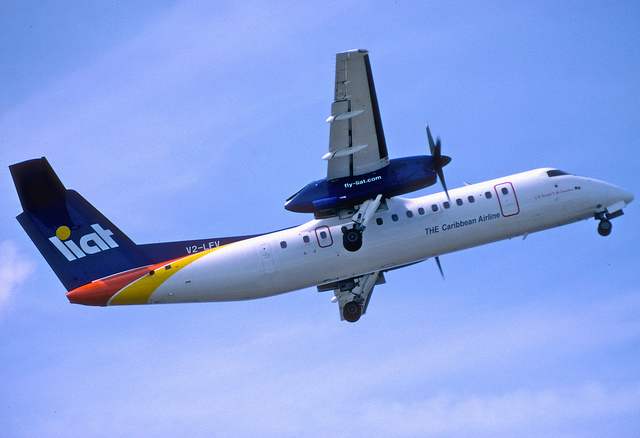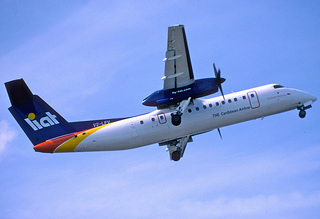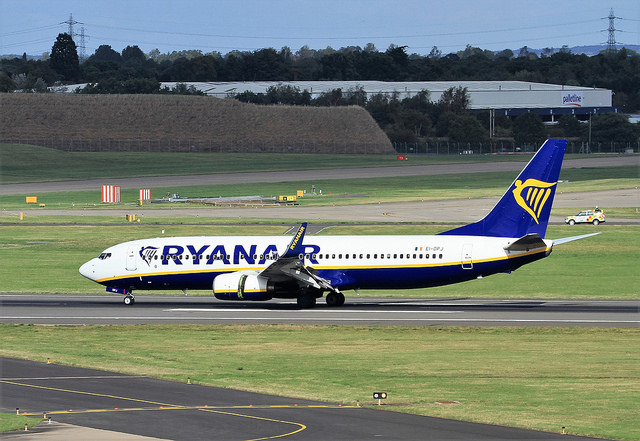LIAT AT42 at Fort de France on Oct 14th 2014, landed short of displaced threshold
Last Update: October 12, 2020 / 17:26:20 GMT/Zulu time
Incident Facts
Date of incident
Oct 14, 2014
Classification
Incident
Airline
LIAT
Flight number
LI-370
Departure
Saint Lucia, Saint Lucia
Destination
Fort de France, Martinique
Aircraft Registration
V2-LIK
Aircraft Type
ATR ATR-42
ICAO Type Designator
AT42
Airport ICAO Code
TFFF
The French BEA reported in their weekly bulletin that the aircraft touched down on runway 10 short of the displaced threshold and impacted obstacles indicating the beginning of the shortened runway. The occurrence was rated a serious incident, the BEA have opened an investigation into the occurrence.
The occurrence aircraft was unable to continue its schedule. Following repairs the aircraft was able to resume service about 29 hours after landing.
On Sep 24th 2020 the French BEA released their Final Report in French only (Editorial note: to serve the purpose of global prevention of the repeat of causes leading to an occurrence an additional timely release of all occurrence reports in the only world spanning aviation language English would be necessary, a French only release does not achieve this purpose as set by ICAO annex 13 and just forces many aviators to waste much more time and effort each in trying to understand the circumstances leading to the occurrence. Aviators operating internationally are required to read/speak English besides their local language, investigators need to be able to read/write/speak English to communicate with their counterparts all around the globe).
The report concludes the probable causes of the serious incident were:
Inadequate flight preparations by the crew and lack of alert by operations contributed to a lack of knowledge of the temporary provisions related to work on the runway.
During the flight although the presence of works was reported to the crew on several occasions, only ATIS formally specified a displaced threshold. However, the position of the displaced threshold was not reported to the crew during the approach (blue markings, APAPI).
Although the crew visually picked up the three crosses laid at the first 600 meters of the runway, the crew chose a touch down point past the three crosses but before the displaced threshold in an area that was still under construction.
The controller's detection of the trajectory deviation from the temporary glidepath was too late to allow an intervention to avoid the serious incident.
The BEA reported the first officer had operated into Fort de France the previous day, when operations were still normal and the entire runway 10/28 was available.
The captain was pilot monitoring, the first officer was pilot flying.
The aircraft was running about 3:10 hours later upon arrival in Saint Lucia. During their stop in Saint Lucia the crew was informed Fort de France was about to close. The aircraft thus departed Saint Lucia with a delay of 2:50 hours. On first contact with Fort de France the controller assured, the airport would not close until the aircraft had landed, instructed the crew to not descend below 2000 feet and instructed the crew to exercise caution while overflying the work area, however, did not provide information about the position of the displaced threshold/length of runway remaining. The crew made their approach briefing.
The captain was monitoring ATIS which reported 1500 meters of runway were available for landing, but did not specify the threshold for runway 10 was displaced. The captain subsequently requested and received clearance to land, the controller again stated 1500 meters of runway were available, however, did not mention threshold runway 10 was displaced.
During the approach the first officer noticed the PAPIs were not working, but was not concerned. The first officer continued for a manual landing on runway 10.
The controller queried the crew to focus on the altitude of the aircraft.
Seconds later the aircraft touched down 940 meters down the runway, only after the aircraft had contacted a barrier the first officer got sight of the APAPI (temporary PAPIs). He only then realized, that the red lights he had seen in the far distance, too far away as he had thought, were the active PAPIs. The first officer stated the previous day he had landed at the regular threshold of the runway.
There were no injuries, the left main gear received damage as result of the collision with the barriers.
The captain had joined LIAT in 2000, accumulated 5,317 hours since and was promoted captain in 2009.
The first officer joined LIAT in 2007 and accumulated 3,517 flying hours.
The BEA analysed that the first officer had been assigned to the flight on short notice. When he arrived at the airport, the flight was already significantly delayed and he had little time to prepare for the flight. The captain, who had remained on board for two hours, was engaged with managing the passengers and the delay. Due to lack of information arriving from the operations department the crew thus departed Saint Lucia with the NOTAMs and AIP SUP for Fort de France, thus only had limited knowledge of Fort de France and thus were not aware of the temporary landing procedures at Fort de France. The previous day such restrictions had not existed when the first officer operated into Fort de France and landed on the regular threshold runway 10 with the runway 10 full length being available.
When the captain received information only 1500 meters of runway were available, he did inform the first officer, but did not mention - just like ATIS - the displaced threshold. This information is repeated during the approach briefing without the crew being aware of the presence of APAPIs and the displaced threshold.
When the tower controller again mentioned 1500 meters were available, he again did not mention the displaced threshold or APAPIs and thus left ambiguities and uncertainties even though the instruction to exercise caution while overflying the area of works suggested a displaced threshold.
While performing the visual approach to runway 10 the first officer sighted the three white crosses over the first 600 meters of the runway which appeared to have been reconstructed already, the first officer perceived the runway past the crossed to be available and touched down in the area between the white crosses and the actual displaced threshold, in an area of ongoing works, which was unoccupied at the time of the landing.
The crew had been surprised by the non-functioning PAPIs but did not have any concern and continued the approach.
Blue marks to indicate the displaced threshold are insufficient salient information to challenge the intended landing path. The crew did not perceive the APAPIs. The controller did not notice the deviation from the vertical trajectory in time. The controller instructed a go around after the aircraft had already touched down, the crew continued the landing however.
The airport operator had prepared several safety barriers including the runway markings, the APAPI and information about the presence of works on NOTAMs and AIP SUP. White crosses were used to mark the unusable area of the runway, however, were not introduced to the begin and end of unusable area but only the first 600 unusable meters, where the works had already been completed (in 2013).
The operating manual of the operator required the captain fetches all pertinent documentation from the operator's operations office including NOTAMs, AIP SUP etc. The first officer would then pick up the envelope. The short time available to prepare for the flight and the habit of going to the same airfields over and over again cause pilots to only take limited knowledge of the documentation received. The pilots rather trust that operations would alert them to an particularity of a flight. Checks with several foreign operators showed that the flight crews were not aware of the information contained in the flight records.
At the time of the occurrence the operator's operations department did not have the nominal number of staff which may have impaired the department's ability to alert the crew of the changes at Fort de France.
On Oct 12th 2020 the BEA released their final report in English (editorial note: the summary above is based on the French report and translation by AVH).
Metars:
TFFF 141800Z AUTO 18009KT 150V210 9999 ///TCU 33/24 Q1012
TFFF 141730Z AUTO 19009KT 160V220 9999 FEW034 33/24 Q1012
TFFF 141700Z AUTO 19009KT 9999 BKN033 BKN047 BKN064 34/25 Q1012
TFFF 141630Z AUTO 19009KT 9999 BKN031 BKN037 34/25 Q1013
TFFF 141600Z AUTO 19008KT 140V230 9999 BKN032 BKN038 BKN049 33/23 Q1013
TFFF 141530Z AUTO 17007KT 110V220 9999 BKN032 BKN038 34/24 Q1014
TFFF 141500Z AUTO 15008KT 100V200 9999 SCT031 33/24 Q1014
TFFF 141430Z AUTO 17007KT 140V210 9999 BKN030 BKN040 33/24 Q1014
TFFF 141400Z AUTO 17006KT 130V210 9999 FEW029 32/25 Q1015
TFFF 141330Z AUTO 15006KT 090V210 9999 SCT031 SCT052 32/25 Q1015
TFFF 141300Z AUTO 14006KT 100V180 9999 SCT025 BKN044 BKN050 31/25 Q1015
TFFF 141230Z AUTO 13004KT 080V160 9999 NSC 31/25 Q1014
TFFF 141200Z AUTO VRB03KT 9999 NSC 29/26 Q1014
TFFF 141130Z AUTO VRB02KT 9999 NSC 27/26 Q1014
TFFF 141100Z AUTO VRB02KT 9999 NSC 25/25 Q1013
TFFF 141030Z AUTO 07002KT 9999 NSC 24/24 Q1013
Incident Facts
Date of incident
Oct 14, 2014
Classification
Incident
Airline
LIAT
Flight number
LI-370
Departure
Saint Lucia, Saint Lucia
Destination
Fort de France, Martinique
Aircraft Registration
V2-LIK
Aircraft Type
ATR ATR-42
ICAO Type Designator
AT42
Airport ICAO Code
TFFF
This article is published under license from Avherald.com. © of text by Avherald.com.
Article source
You can read 2 more free articles without a subscription.
Subscribe now and continue reading without any limits!
Read unlimited articles and receive our daily update briefing. Gain better insights into what is happening in commercial aviation safety.
Send tip
Support AeroInside by sending a small tip amount.
Related articles
LIAT DH8C at Georgetown on Aug 26th 2013, dropped main wheel on takeoff
A LIAT de Havilland Dash 8-300, registration V2-LFV performing flight LI-774 from Georgetown (Guyana) to Bridgetown (Barbados) with 43 passengers,…
LIAT DH8C near Pointe a Pitre on May 26th 2013, smoke in cabin
A LIAT de Havilland Dash 8-300, flight LI-512 from Bridgetown (Barbados) to Antigua (Antigua), was enroute about 10nm from Pointe a Pitre…
LIAT DH8C near St. Maarten on Sep 25th 2012, burning smell in cockpit
A LIAT de Havilland Dash 8-300, flight LI-368 from Antigua (Antigua) to Anguilla (Anguilla), was enroute near Saint Maarten when the crew detected a…
Newest articles
Buffalo B732 at Goose Lake and Yellowknife on Oct 20th 2025, uncommanded nose gear extension and collapse
A Buffalo Airways Boeing 737-200, registration C-GTVO performing flight J0-202 from Goose Lake,NU to Yellowknife,NT (Canada) with 3 crew on board,…
Ryanair B738 at Cluj on Nov 3rd 2025, first officer incapacitated
A Ryanair Boeing 737-800, registration EI-DPJ performing flight FR-2682 from Milan Bergamo (Italy) to Cluj (Romania), was descending towards Cluj…
Subscribe today
Are you researching aviation incidents? Get access to AeroInside Insights, unlimited read access and receive the daily newsletter.
Pick your plan and subscribePartner

ELITE Simulation Solutions is a leading global provider of Flight Simulation Training Devices, IFR training software as well as flight controls and related services. Find out more.
SafetyScan Pro provides streamlined access to thousands of aviation accident reports. Tailored for your safety management efforts. Book your demo today
AeroInside Blog
Popular aircraft
Airbus A320Boeing 737-800
Boeing 737-800 MAX
Popular airlines
American AirlinesUnited
Delta
Air Canada
Lufthansa
British Airways



